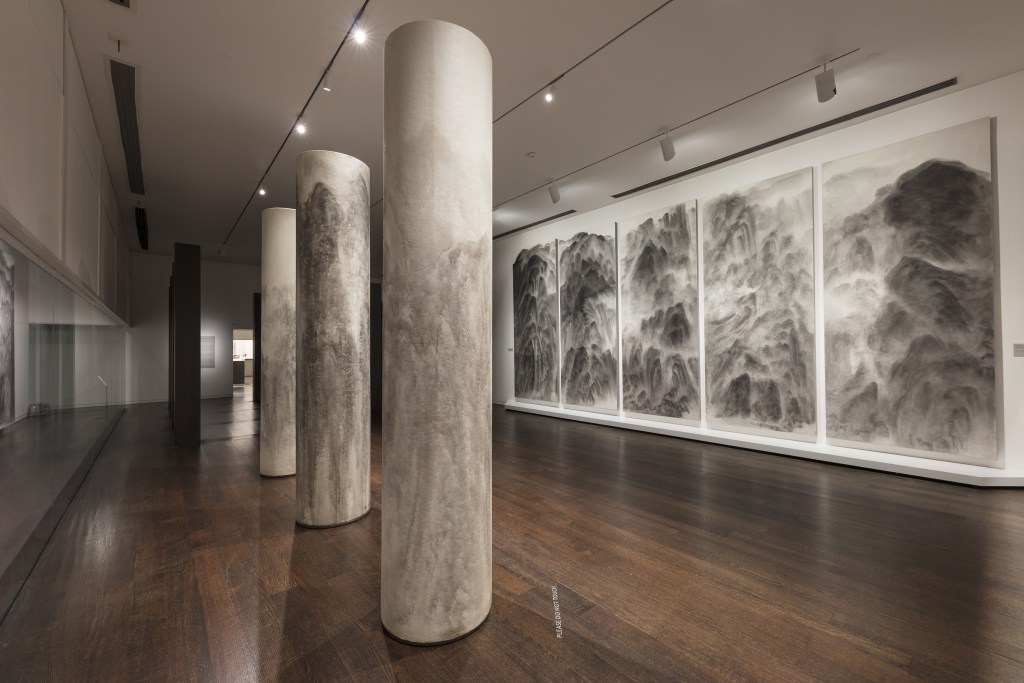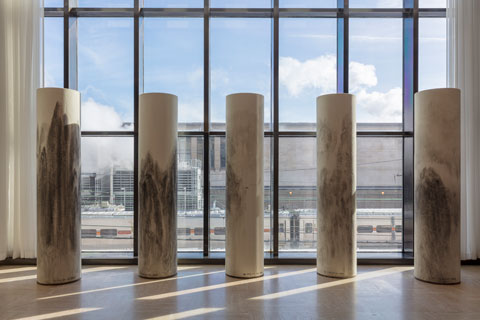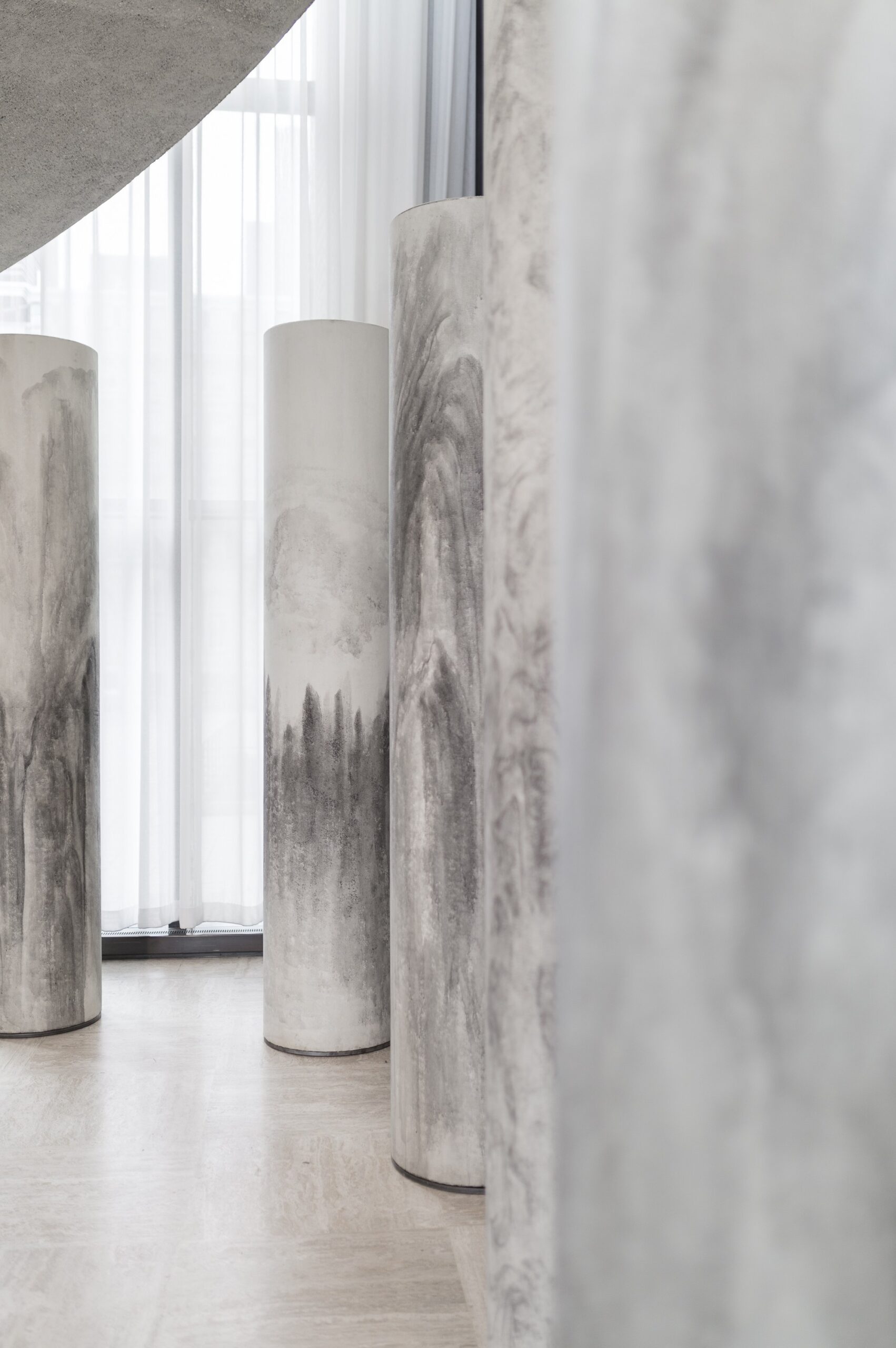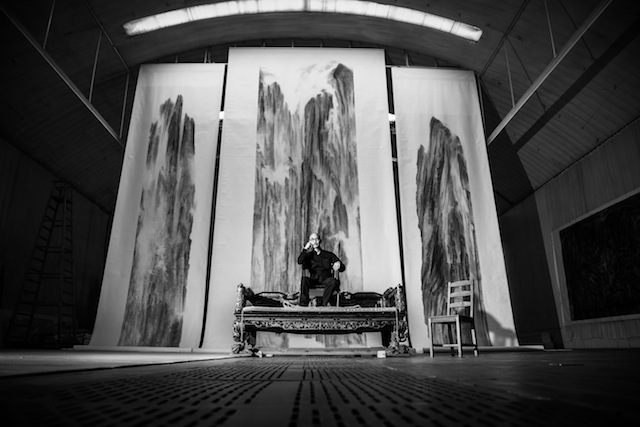Each monochromatic painting was specifically made for it’s location.
Image courtesy of: New City Art

Each monochromatic painting was specifically made for it’s location.
Image courtesy of: New City Art
Over the summer, all of us in Chicago were fortunate enough to have Xu Longsen’s amazing “Light of Heaven” installation at the Art Institute of Chicago. Within the museum’s galleries of Chinese, Japanese and Korean Art; curators installed a series of 36 impressive pieces. A few pillars are small, but most are quite large in stature, a style that’s become Longsen’s signature and which has required him to work in a Beijing studio which could easily double as a banquet hall. The largest and most impressive piece is an ink-on-felt pillar which stands 26 feet tall and shows a beautiful mountain landscape.
This installation, specific to the Art Institute galleries, was installed at the Ando Gallery, designed by the renowned Japanese artist, Tadao Ando.

Longsen’s pieces transcend time… starting out with traditional materials and techniques, they magically meld to meet present day’s contemporary style and way of presentation.
Image courtesy of: Art Institute of Chicago
A traditional Taoist artist, Longsen knows his art as he came to prominence in the early 2000’s and was also a gallery owner specializing in oil painters from China during 1912-1949. He was very specific with what he wanted his audience to see. Thus, walking into the galleries allows for total immersion. Each of the three walls is covered by ink paintings of a specific size, proportion and theme. Each piece within each series has a specific character. Most interesting are the paintings which wrap around 3 10-foot pillars… all of them are tied into one main idea!
In Chinese, shanshui means landscape; specifically, mountains and water. Moreover, shanshui is the name given to ink landscape painting which dates back to the Six Dynasties period (220-589). For those of us previously unfamiliar with shanshui, what a better introduction?

Longsen’s shanshuis are fluid, resembling smoke or mist. The mountains are neither heavy nor substantial; rather, the mountains look as though they’re floating about.
Image courtesy of: New City Art
We love the revival of traditional Chinese landscape paintings that’s occurred, partially, through Longsen’s art. These specific landscape paintings are inspired by Mount Kunlun, a mythological mountain range which is believed to be home to many Chinese gods and goddesses. In essence, Mount Kunlun is considered to be the place where Heaven and Earth converge. Viewed up close, the works look abstract and might even resemble splatter paintings; but take a few steps back and the shapes morph into recognizable hills, valley and crests.
Within the Ando Gallery, the dimly lit gallery is lit up a bit stronger than normal. And away from the traffic of the museum’s more famous galleries, this specific space is the perfect spot for quiet reflection and perhaps, meditation.

This pillar, coming up through the spiral staircase, is perhaps the most impressive of the collection. The ink-on-felt pillar rises 26 feet and nearly reaches the double-height entryway of the Art Institute’s Morton Wing.
Image courtesy of: Artsy
Born in Shanghai and a graduate of the Shanghai College of Arts and Crafts, Longsen is regarded as one of the most creative artists of his generation in China. “Light of Heaven” is unique in that it transports the viewer back in time and allows them to envision how the 19th-century audience would have felt about such immense and inspiring pillars.
Nowhere are there humans in the installations. This is important to note because it shows us that as the universe created us, the universe will destroy us… and we can’t stop it from happening.

“Wing on the Mountain” at Hong Kong’s Hanart TZ Gallery.
Image courtesy of: Tatinis
Standing by the columns or “taking in” the paintings, there’s an energy that transcends. This exhibition is now over, but hopefully it will find it’s way back to the Ando Gallery in Chicago at some point in the near future!